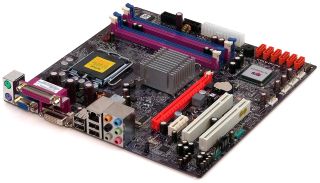Shuttle XS29F: Is VIA's Nano Processor Powerful Enough?
The MicroATX Alternative
Both of today’s low-energy compact platforms are configured as barebones PCs, a market long-served by Micro ATX competitors. Yet most of those Micro ATX competitors come at low-ball prices using low-quality cases and power supplies. We decided to put something together to represent a similarly-priced market using Intel’s 35W Celeron 430.

Using an older 65nm production technology (the same scale as VIA’s Nano series), Intel's Conroe-based Celeron 430 offers reduced power consumption via a relatively low 1.80 GHz clock speed, with additional power savings coming from the fact that Intel disabled one of its two processing cores.

The ECS G45T-M2 provides slightly upscale features compared to motherboards of low-cost prebuilt systems, starting with its G45 Express northbridge and ICH10 southbridge. Integrated X4500HD graphics support HD video acceleration, a feature lacking from the cheaper G43. Even bigger cost savings could be found in the G41 chipset, which reduces USB 2.0 support from twelve to eight total ports through the older ICH7 southbridge.
The G43 is specifically targeted at the same office use we were hoping to address in today’s platform comparison, yet with the same power consumption for both versions and no HD video test in today’s benchmarks, it was easier for us to use the version we had on hand. Low-cost pre-built systems will typically come with the even cheaper G41 and often have the PCI Express x16 slot omitted.
Combining the $40 Celeron 430 processor and $70 G45T-M2 motherboard with a good-quality microATX case and power supply combo brings the total cost of this “barebones microATX solution” to $170-$210, compared to $190 for the X27D. The XS29F has not yet been priced.
Stay on the Cutting Edge
Join the experts who read Tom's Hardware for the inside track on enthusiast PC tech news — and have for over 25 years. We'll send breaking news and in-depth reviews of CPUs, GPUs, AI, maker hardware and more straight to your inbox.
Current page: The MicroATX Alternative
Prev Page Shuttle X-Type Drive Installation Next Page Test Setup And Benchmark Configuration-
Wouldn't this just be a linux-only machine then? I can't possibly see any other use for it other than maybe a childs pc or a general "Internet & Email only" PC.Reply
-
pakardbell486dx2 This may be a dumb question, but why was Xp not used for this test? Clearly "just barely" wont work for people who spend their hard earn money on something like this. Maybe the celeron is ok for vista basic but the atom and nano platforms are just not good enough for Vista. If I can make an analogy comparing Vista and Atom/Nano it's like an old 73' Corolla trying to haul ten tons uphill.Reply -
tacoslave amd huron platform thats all i have to say i want to see it benched see how it stakes up.Reply -
Blueridge I agree that the major drawback of this review is the use of Microsoft Vista. I think that Windows XP Home edition for ULPC or a netbook spin of a linux distro (e.g. Ubuntu) would have been a much better choice for this review, especialy since is very well known that Vista is just not the right choice for netbooks (or nettops). Some time ago I read several reviews of the nano processor, based on Win XP and they performed more than OK, they were even suitable for a small HTPC at that time (the toughest challenge was DVD playback back then) and with a better chipset would have performed even netter. But this happens when a resource hungry OS like vista is used... just my 2 cents.Reply -
HalfHuman i guess a windoze xp or 7 would be a lot better to use with this kind of hardware. in fact i cannot think at a more inapropriate os to run on a nentop than vista. :)Reply
maybe the performance delta would be the same but the usability would be more than "acceptable".
regarding the "benchmarking" stuff... i do not think that anybody sane would buy a nettop to use it for hardcore photo editiing or transcoding.
if i'd buy a nettop i'd be interested in several factors:
- to be powerfull enough for office work and maybe hd playback
- to use as little power as possible (which nano does nicely) as this kind of device would be rarely powered down
- to be silent (which nano is)
i think that performance per watt is irrelevant here as a system like this is not meant to be "performant". i think that the one that uses less watts, has more features is queter wins here.
my take on this is that via has a very nice platform and nano wins even if it's not the fastest. -
Blueridge I just took a look at Via's website and it seems that Nano is available in flavors up to 1.8GHz. I wish a machine based on such a processor was used for this review, though I think the main issue here is availability.Reply -
HalfHuman i would be nice to see some noise evaluations, some hd playback tests... some appropriate os. :)Reply -
eddieroolz The Nano would be the perfect computer to just leave it powered on, seeding torrents and such.Reply
Most Popular


